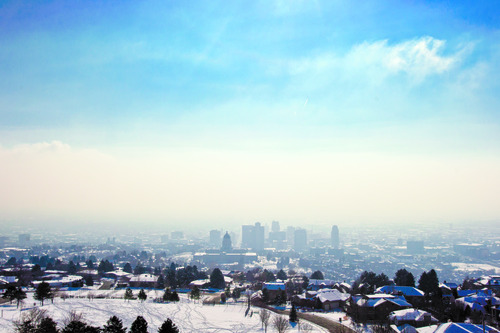This is an archived article that was published on sltrib.com in 2013, and information in the article may be outdated. It is provided only for personal research purposes and may not be reprinted.
Two spots in Utah are among the nation's worst when it comes to spikes of pollution, says the American Lung Association's "State of the Air 2013" ranking.
The famous episodes of high microscopic soot pollution, known as PM 2.5, made the corridor from Salt Lake County to Weber County the sixth worst in the nation, while Cache Valley was 10th, the group said.
The health-advocacy organization noted some positive trends nationwide. Its latest report said communities have progressed in reducing year-round particle pollution. And the long-term trend is for lower pollution nationwide.
At the same time, some cities with the worst pollution had more unhealthy days of high summer smog and PM 2.5 spikes than in 2011. About 42 percent of U.S. residents, about 131.8 million people, endure unhealthy levels of pollution sometime during the year.
"We are happy to report that the state of our air is much cleaner today than when we started the 'State of the Air' report 14 years ago," said Harold Wimmer, the association's president and CEO.
"But the work is not done, and the Environmental Protection Agency must continue the work necessary to achieve the promise of the Clean Air Act: healthy air that is safe for all to breathe."
The American Lung Association (ALA) did find some bright spots in Utah in its report.
St. George is listed among the top 16 cleanest cities for particle pollution, Logan is on the cleanest-cities list for ozone, and the year-round average for particle pollution and ozone levels improved in Salt Lake County compared with previous years.
"Even though Salt Lake City has experienced increases in unhealthy days of short-term particle pollution, the air quality is still better compared to a decade ago," said Glenn Lanham, executive director at the American Lung Association in Utah. "But we must set stronger health standards for pollutants and cleanup sources of pollution in Salt Lake City to protect the health of our citizens."
Donna Spangler, spokeswoman for the Utah Department of Environmental Quality, acknowledged the state does have days when air pollution exceeds the federal health standard. "Any time that happens, it is unacceptable. But for the most part, Utah has clean air much of the year," she said. "We appreciate the American Lung Association raising the awareness of air quality as it is one of DEQ's top priorities as tasked by Governor Herbert.
"Beginning this year, the Utah Division of Air Quality has put in action a set of new rules intended to significantly improve wintertime particulate pollution as a result of years-long planning efforts that involved hundreds of stakeholders," Spangler said.
Another standout on this year's ALA report for Utah: high ozone levels in Uintah County, which is grappling with an unusual ozone winter problem linked to oil and gas development in the Uinta Basin.
The association noted there were nine days of "very unhealthy" ozone pollution in the basin, 21 "unhealthy" days and 34 days when pollution levels made the air unhealthy for people in sensitive groups: the young, the old and people with heart and lung problems.
Uintah County received an F grade as a result, and Salt Lake County also received an F for ozone, with 15 days of ozone in the range considered unhealthy for people in sensitive groups.
Meanwhile, the association gave F grades to six Utah counties: Salt Lake (with 42 days of pollution harmful to people in sensitive groups); Weber (28); Utah (25); Cache (28); Davis (10); and Box Elder (8).
Cherise Udell, founder of Utah Moms for Clean Air, said she was disappointed but not surprised by the latest F grades. She criticized Utah political leaders for not responding to the public's concern about pollution.
"We elect them to solve our state's problems," she said. "This year, they chose to ignore one of our biggest problems, a public health problem."
Udell said she has not heard back from Gov. Gary Herbert's office on an air cleanup plan her group put together nearly two months ago.
"We cannot do it ourselves," she said. "It's a collective problem that requires collective action."
The lung association's analysis suggests at least one-third of Utah is vulnerable to pollution impacts. More than 1 million residents of the 2.8 million population are 18 and under or 65 and older. About 230,000 have asthma, and nearly 494,000 have cardiovascular disease.
Breathing polluted air is associated with asthma emergencies, missed school and work, heart attacks and even premature death.
In Utah, the dogged appearance of winter smog prompted demonstrations in Herbert's office and rallies on Capitol Hill.
State lawmakers responded by filing a flurry of legislation, but passed only two minor bills.
Twitter: @judyfutah





